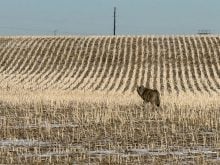Farmers just south of the border took one look at wheat prices and, like their neighbors north of the line, planted canola.
United States farmers, primarily in North Dakota, planted 35 percent more acres to canola this year, seeding a record 1.133 million acres.
Mark Ash, an agricultural economist with the U.S. Department of Agriculture’s economic research service, said farmers weren’t pleased with grain prices.
“Prices for high oil crops like canola have been relatively attractive by comparison,” he said.
And now that farm support payments aren’t tied to wheat and barley acreage, they’re free to plant what they want, said Ash.
Read Also

Agritechnica Day 2: The future of tractor power, building quicker crop apps and large farms and tech
Agritechnica Day 2: The future of tractor power, building quicker crop apps with Syngenta and large farms and tech
They’ve also been plagued by wheat scab (fusarium head blight), and saw canola as an alternative.
Ash thinks the trend to bigger U.S. canola crops will continue, with farmers planting about two million acres in a few years.
Much will depend on the world wheat market, he said.
“There’s so many different suppliers in the world that the wheat market is probably not going to be very strong, price-wise, so I would think that would continue to encourage more canola acreage.”
Most U.S. canola goes to the domestic crushing market. Last year, farmers averaged $285 (U.S.) per tonne, said Ash.
This year, because of higher oilseed production around the world, he thinks average prices will fall to between $243 to $264 per tonne.
“There will be more supplies, the demand for the seed will probably be fairly strong yet, but maybe not as strong as it was in the current year,” said Ash.
Greg Kostal, analyst with Pro Farmer Canada, said he thinks U.S. crushers will import less Canadian canola this year because of the higher U.S. production of canola, sunflowerseed and flax.
Normally, U.S. crushers buy 300,000 to 350,000 tonnes of canola from Canada, he said.
U.S. growers planted more than twice as much flax as they did last year, seeding 335,000 acres, said Ash.
Flax loses limelight
At one time, flax was a significant crop in the U.S. In the mid-1960s, farmers planted up to three million acres. It has been in steep decline since, said Ash, as other crops became more lucrative to grow.
But now, flax is another alternative to wheat, especially for farmers in North Dakota.
Ash expects production to increase, but said it will never be as large as it once was.
Kostal said the increase in flax this year is another stake in the heart of Canadian price prospects. “It’s so demand-sensitive,” he explained.
U.S. crushers usually take about 200,000 tonnes of Canadian flax. But in the coming crop year, he expects flax exports to be lower than 150,000 tonnes.
“We’re going to need Europe to take the surplus,” he said, adding prices will probably have to drop lower to stimulate buying.














